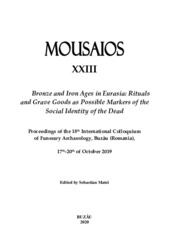Prikaz osnovnih podataka o dokumentu
The Abundance Revealing Status? First Iron Age Princely Necropolises in Western Serbia and their Relation to the Common Funerary Practice
| dc.contributor | Matei, Sebastian | |
| dc.creator | Dmitrović, Katarina | |
| dc.creator | Ljuština, Marija | |
| dc.date.accessioned | 2023-11-02T12:26:26Z | |
| dc.date.available | 2023-11-02T12:26:26Z | |
| dc.date.issued | 2020 | |
| dc.identifier.issn | 1582-0688 | |
| dc.identifier.uri | http://reff.f.bg.ac.rs/handle/123456789/5115 | |
| dc.description.abstract | The paper treats different features of grave inventories in the First Iron Age graves in western Serbia. The number of objects in grave inventory and quality of each item are set as the main criteria for determination of groups. It is supposed that the quantity and quality of the grave goods, as well as massiveness of the grave structure and its position, represent the features that reveal status of the deceased. | sr |
| dc.language.iso | en | sr |
| dc.publisher | Muzeul Judeţan Buzău, Buzău. | sr |
| dc.rights | openAccess | sr |
| dc.rights.uri | https://creativecommons.org/licenses/by/4.0/ | |
| dc.source | Musaios XXIII: Bronze and Iron Ages in Eurasia: Rituals and Grave Goods as Possible Markers of the Social Identity of the Dead. Proceedings of the 18th International Colloquium of Funerary Archaeology, Buzău (Romania), 17th-20th October 2019 | sr |
| dc.subject | Western Serbia | sr |
| dc.subject | Iron Age | sr |
| dc.subject | tumulus necropolises | sr |
| dc.subject | princely graves | sr |
| dc.subject | funerary practice | sr |
| dc.subject | relations | sr |
| dc.title | The Abundance Revealing Status? First Iron Age Princely Necropolises in Western Serbia and their Relation to the Common Funerary Practice | sr |
| dc.type | article | sr |
| dc.rights.license | BY | sr |
| dc.citation.epage | 113 | |
| dc.citation.spage | 103 | |
| dc.identifier.fulltext | http://reff.f.bg.ac.rs/bitstream/id/12616/bitstream_12616.pdf | |
| dc.identifier.rcub | https://hdl.handle.net/21.15107/rcub_reff_5115 | |
| dc.type.version | publishedVersion | sr |

